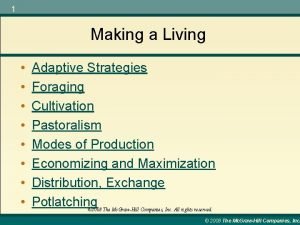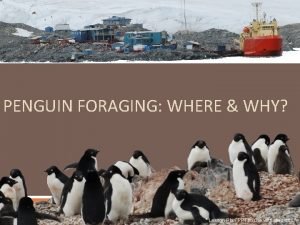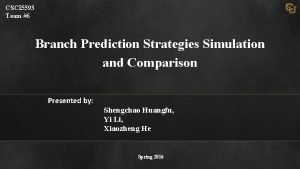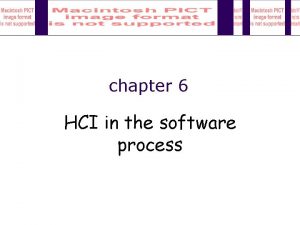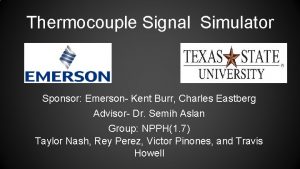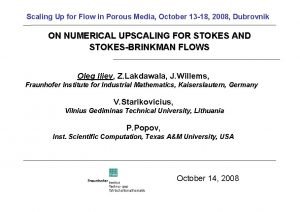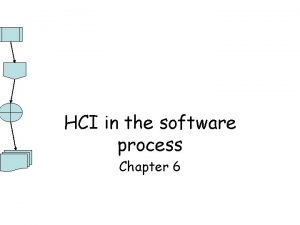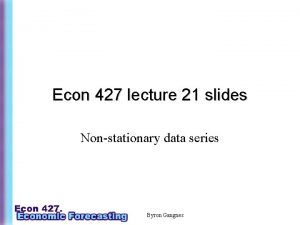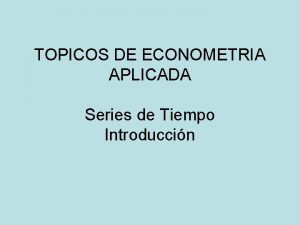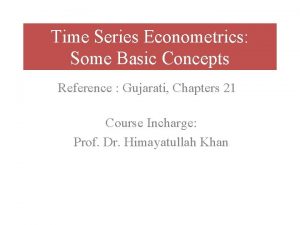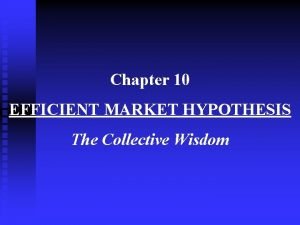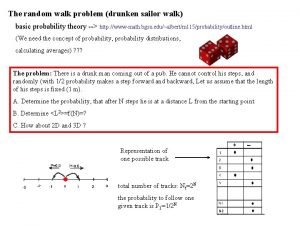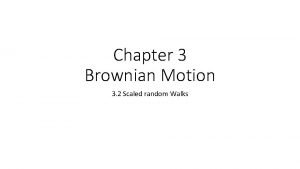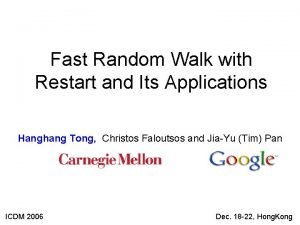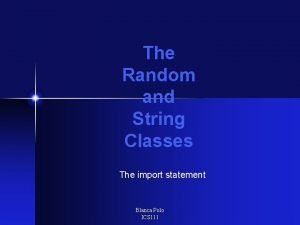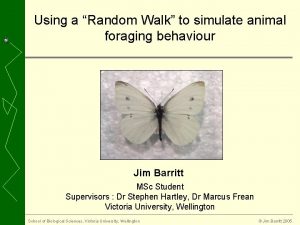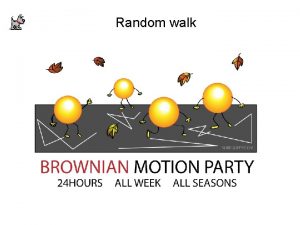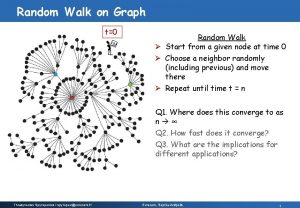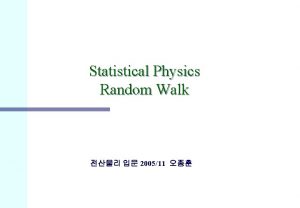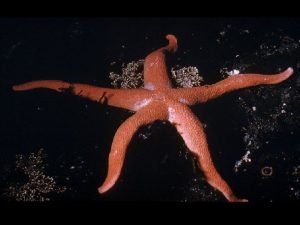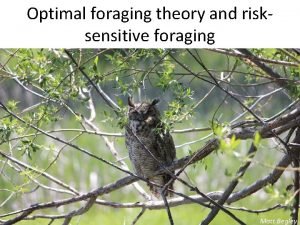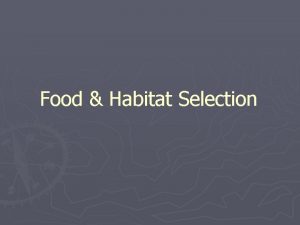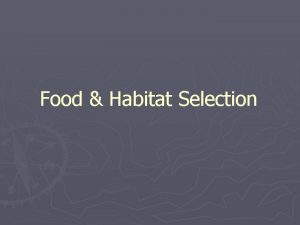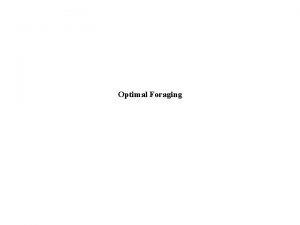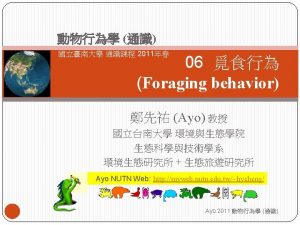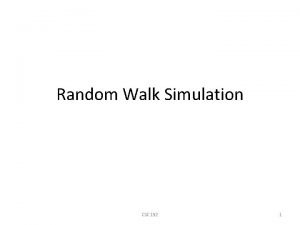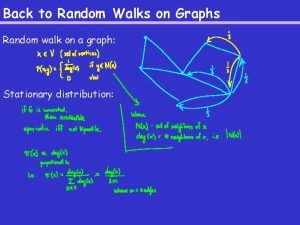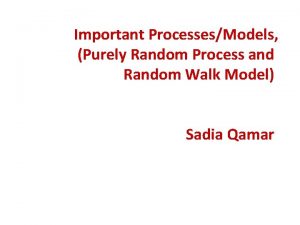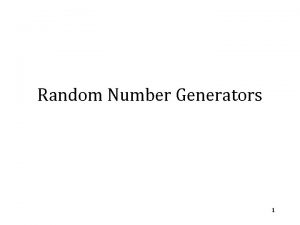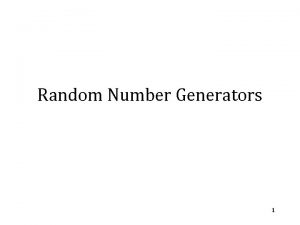Using a Random Walk to simulate the foraging
































































- Slides: 64

Using a “Random Walk” to simulate the foraging behaviour of Pieris rapae http: //www. oulu. fi/ Jim Barritt Supervised and helped by Dr Stephen Hartley, Dr Marcus Frean, Marc Hasenbank Victoria University, Wellington School of Biological Sciences, Victoria University, Wellington © Jim Barritt 2006

Talk outline • Background • Theory • Simulation http: //www. oulu. fi/ • Results • Conclusion / Future work 1 School of Biological Sciences, Victoria University, Wellington © Jim Barritt 2006

Background • Part of a project investigating insect foraging interactions (Pieris rapae) - Dr. Stephen Hartley, Marc Hasenbank - Session 15 - “Egg laying on patchy resources and the importance of spatial scale” • Simulation in conjunction with field studies 2 School of Biological Sciences, Victoria University, Wellington © Jim Barritt 2006

Theory - the Oviposition Question Which cabbage ? Pieris rapae 3 School of Biological Sciences, Victoria University, Wellington © Jim Barritt 2006

Theory - Resource concentration ? • Is there a relationship between eggs per plant and plant density ? - - Concentration: Higher plant density should provide more information (e. g. olfactory cues) so animals are expected to locate dense patches easily and remain within them. This would lead to more eggs per plant on high density patches - Root (1973) Resource concentration Dilution: Foraging animals may not remain in high density stands, instead moving around at a constant rate irrespective of plant density. This produces more eggs per plant on low density plants or egg “spreading” behaviour - Yamamura (1999) Resource dilution - Ideal free distribution: Complete information / access leads to the eggs being distributed evenly Low Density - High Density Depends on patterns of movement Ideal free distribution 4 School of Biological Sciences, Victoria University, Wellington © Jim Barritt 2006

Theory - Resource concentration ? • Is there a relationship between eggs per plant and plant density ? - - Concentration: Higher plant density should provide more information (e. g. olfactory cues) so animals are expected to locate dense patches easily and remain within them. This would lead to more eggs per plant on high density patches - Root (1973) Resource concentration Dilution: Foraging animals may not remain in high density stands, instead moving around at a constant rate irrespective of plant density. This produces more eggs per plant on low density plants or egg “spreading” behaviour - Yamamura (1999) Resource dilution - Ideal free distribution: Complete information / access leads to the eggs being distributed evenly Low Density - High Density Depends on patterns of movement Ideal free distribution 5 School of Biological Sciences, Victoria University, Wellington © Jim Barritt 2006

Theory - Resource dilution ? • Is there a relationship between eggs per plant and plant density ? - - Concentration: Higher plant density should provide more information (e. g. olfactory cues) so animals are expected to locate dense patches easily and remain within them. This would lead to more eggs per plant on high density patches - Root (1973) Dilution: Foraging animals may not remain in high density stands, instead moving around at a constant rate irrespective of plant density. This produces more eggs per plant on low density plants or egg “spreading” behaviour - Yamamura (1999) - free distribution: Complete information / access leads to the eggs being distributed evenly - Depends on patterns of movement Ideal Low Density Resource concentration Resource dilution High Density Ideal free distribution 6 School of Biological Sciences, Victoria University, Wellington © Jim Barritt 2006

Theory - Ideal free distribution ? • Is there a relationship between eggs per plant and plant density ? - - • Concentration: Higher plant density should provide more information (e. g. olfactory cues) so animals are expected to locate dense patches easily and remain within them. This would lead to more eggs per plant on high density patches - Root (1973) Dilution: Foraging animals may not remain in high density stands, instead moving around at a constant rate irrespective of plant density. This produces more eggs per plant on low density plants or egg “spreading” behaviour - Yamamura (1999) Resource concentration Resource dilution Ideal free distribution: Complete information / access leads to the eggs being distributed evenly It depends on patterns of movement Ideal free distribution 7 School of Biological Sciences, Victoria University, Wellington © Jim Barritt 2006

Simulation • Two seasons of field observations (Marc Hasenbank) • How do patterns of movement create the observed response ? - Published simulations: Jones (1977), Cain (1985), Byers (2001) Random vs force of attraction (incorporate perceptual information? ) • How do we simulate ? - 8 Quantify movement paths Create conceptual model - what is a random walk ? Run simulation experiment! School of Biological Sciences, Victoria University, Wellington © Jim Barritt 2006

Quantifying movement paths Animal moves continuously in space Start 9 School of Biological Sciences, Victoria University, Wellington © Jim Barritt 2006

Quantifying movement paths 7 5 6 8 4 3 2 1 Sample location in space over time Start 10 School of Biological Sciences, Victoria University, Wellington © Jim Barritt 2006

Quantifying movement paths Join the dots to create “Steps” - an abstraction of the real path Start 11 School of Biological Sciences, Victoria University, Wellington © Jim Barritt 2006

Quantifying movement paths Measurements Start 12 School of Biological Sciences, Victoria University, Wellington © Jim Barritt 2006

Random walks - Step 1 • We can simulate the path: - Choose θ (angle of turn) at random (+/- 180°) - Move 1 step length in that direction. . . 0° -90° +/-180° 13 School of Biological Sciences, Victoria University, Wellington © Jim Barritt 2006

Random walks - Step 2 • We can simulate the path: - Choose θ (angle of turn) at random (+/- 180°) - Move 1 step length in that direction - Repeat 0° -90 ° +/-1 80° 14 School of Biological Sciences, Victoria University, Wellington © Jim Barritt 2006

Random walks - Step 3 • We can simulate the path: - Choose an heading at random (+/- 180°) - Move 1 step length in that direction - Repeat ° -90 0° +/18 0° ° +9 0 15 School of Biological Sciences, Victoria University, Wellington © Jim Barritt 2006

Random walks - Step 10 • This is a “Random Walk” (or flight!) - It does not imply that the animal is behaving randomly but that there is a random element involved in the interaction with the environment - Root & Kareiva (1984) Start 16 School of Biological Sciences, Victoria University, Wellington © Jim Barritt 2006

Random walks - correlated steps • Some animals may exhibit “pure” random walks - e. g. Whirligig Beetles (Gyrinus sp. ) • Butterflies have a “direction of travel” and so are more likely to turn with θ around 0° 0° -90° +/-180° • “Correlated” 17 School of Biological Sciences, Victoria University, Wellington http: //insects. tamu. edu © Jim Barritt 2006

Random walks - correlated steps • We can simulate correlation of angle of turn by selecting θ from a probability distribution. . . 0° -90° +/-180° Cain (1985) - demonstrated similar distribution for observed Pieris angles of turn 18 School of Biological Sciences, Victoria University, Wellington © Jim Barritt 2006

Random walks - Correlated steps • After 10 steps. . . Start 19 School of Biological Sciences, Victoria University, Wellington © Jim Barritt 2006

Correlated random walk • More “directional” than “pure” random walk Start 20 School of Biological Sciences, Victoria University, Wellington © Jim Barritt 2006

From theory to simulation • Take the standard deviation (s. d. ) of the probability distribution and the step length. . . 0° -90° +/180° 21 School of Biological Sciences, Victoria University, Wellington © Jim Barritt 2006

From theory to simulation • Provides two simulation parameters, L and A 0° -90° +90° A +/180° L 22 School of Biological Sciences, Victoria University, Wellington © Jim Barritt 2006

Simulation • Visual demonstration with simple cabbage layout • Experiment Parameters • Results 23 School of Biological Sciences, Victoria University, Wellington © Jim Barritt 2006

Visual demonstration - Step 0 L=10 A=20 Butterfly Cabbage Release boundary 24 School of Biological Sciences, Victoria University, Wellington © Jim Barritt 2006

Visual demonstration - Step 1 L=10 A=20 When move outside “world”, removed 25 School of Biological Sciences, Victoria University, Wellington © Jim Barritt 2006

Visual demonstration - Step 2 L=10 A=20 26 School of Biological Sciences, Victoria University, Wellington © Jim Barritt 2006

Visual demonstration - Step 3 L=10 A=20 27 School of Biological Sciences, Victoria University, Wellington © Jim Barritt 2006

Visual demonstration - Step 4 L=10 A=20 28 School of Biological Sciences, Victoria University, Wellington © Jim Barritt 2006

Visual demonstration - Step 6 L=10 A=20 29 School of Biological Sciences, Victoria University, Wellington © Jim Barritt 2006

Visual demonstration - Step 8 L=10 A=20 30 School of Biological Sciences, Victoria University, Wellington © Jim Barritt 2006

Visual demonstration - Step 10 L=10 A=20 31 School of Biological Sciences, Victoria University, Wellington © Jim Barritt 2006

Visual demonstration - Step 11 L=10 A=20 When intersect a cabbage, lay egg and “die” 32 School of Biological Sciences, Victoria University, Wellington © Jim Barritt 2006

Visual demonstration - Step 12 (End) L=10 A=20 33 School of Biological Sciences, Victoria University, Wellington © Jim Barritt 2006

Experiment Parameters • L = step length (0. 5 m to 2 m) • A = s. d angle of turn (20° to 100°) • Cabbage radius = 20 cm, spacing = 25 cm • Large L / Small A = more directional • Small L / Large A = more “wiggle” Directional “Wiggle” • 12, 000 butterflies • 10 replicates 34 School of Biological Sciences, Victoria University, Wellington © Jim Barritt 2006

Experimental Cabbage layout 35 School of Biological Sciences, Victoria University, Wellington © Jim Barritt 2006

Results Simulation 36 School of Biological Sciences, Victoria University, Wellington © Jim Barritt 2006

Results Simulation vs Field 37 School of Biological Sciences, Victoria University, Wellington © Jim Barritt 2006

Results Simulation vs Field 38 School of Biological Sciences, Victoria University, Wellington © Jim Barritt 2006

Results Log Linear Regression Field Resource concentration Simulation Ideal free distribution ✔ Resource dilution H 0 - β=0 Field p-value = 0. 037 Simulation p-value = 0. 0425 r 2 (Field+Simulation) = 0. 9 Ideal free distribution 39 School of Biological Sciences, Victoria University, Wellington © Jim Barritt 2006

Results Log Linear Regression Field Consistent with literature (Yamamura, 1999) Resource concentration Simulation Ideal free distribution ✔ Resource dilution H 0 - β=0 Field p-value = 0. 037 Simulation p-value = 0. 0425 r 2 (Field+Simulation) = 0. 9 40 School of Biological Sciences, Victoria University, Wellington © Jim Barritt 2006

Results - varying parameters L=50 L=100 L=150 L=200 Eggs Per Plant (mean +/stderr) A=20 A=60 A=100 Plant Density 41 School of Biological Sciences, Victoria University, Wellington © Jim Barritt 2006

Results - varying parameters L=50 L=100 L=150 L=200 Eggs Per Plant (mean +/stderr) A=20 A=60 L=200 A=100 Plant Density 42 School of Biological Sciences, Victoria University, Wellington © Jim Barritt 2006

Conclusions • With a simple correlated random walk we can predict egg distributions for Pieris - No attractive force ✔ ✔ • With no attractive force we observe resource dilution • Attractive force could potentially produce resource concentration. . . 43 School of Biological Sciences, Victoria University, Wellington ? © Jim Barritt 2006

Conclusions • With a simple correlated random walk we can predict egg distributions for Pieris - No attractive force ✔ ✔ • With no attractive force we observe resource dilution • Attractive force could potentially produce resource concentration. . . 44 School of Biological Sciences, Victoria University, Wellington ? © Jim Barritt 2006

Conclusions • With a simple correlated random walk we can predict egg distributions for Pieris - No attractive force ✔ ✔ • With no attractive force we observe resource dilution • Attractive force could potentially produce resource concentration. . . 45 School of Biological Sciences, Victoria University, Wellington ? © Jim Barritt 2006

Future Work • Deterministic attraction - Force of attraction (similar to gravity) Perceptual ranges Information gradients / matrix • Random walk influenced by Environment - Move length and Angle of turn as functions of information • Lifecycle: multiple eggs, migration vs birth • Multi-species - Co-existance by having different movement patterns? • Fractal (Levy) Walks and landscape 46 School of Biological Sciences, Victoria University, Wellington © Jim Barritt 2006

Acknowledgements • Thanks to - Dr Stephen Hartley Dr Marcus Frean Marc Hasenbank Victoria University Bug Group - Special thanks to John Clark and the staff of Woodhaven Farm (Levin) - Funded by a Royal Society Marsden grant http: //www. oulu. fi/ 47 School of Biological Sciences, Victoria University, Wellington © Jim Barritt 2006

Questions ? • With a simple correlated random walk we can predict egg distributions for Pieris ✔ ✔ • With no attractive force we observe resource dilution • Attractive force could potentially produce resource concentration. . . 48 School of Biological Sciences, Victoria University, Wellington ? © Jim Barritt 2006

References Aldrich, J. (1997). R. A. Fisher and the making of maximum likelihood 1912 -1922. Statistical Science 12, pp. 162 -176. Bukovinszky, T. , R. P. J. Potting, Y. Clough, J. C. van Lenteren, and L. E. M. Vet. (2005). The role of pre- and post-alighting detection mechanisms in the responses to patch size by specialist herbivores. Oikos 109, pp. 435 -446. Byers, J. A. (2001). Correlated random walk equations of animal dispersal resolved by simulation. Ecology 82, pp. 1680 -1690. Cain, M. L. (1985). Random Search by Herbivorous Insects: A Simulation Model. Ecology 66, pp. 876 -888. Finch, S. , and R. H. Collier. (2000). Host-plant selection by insects - a theory based on 'appropriate/inappropriate landings' by pest insects of cruciferous plants. Entomologia Experimentalis Et Applicata 96, pp. 91 -102. Fretwell, S. D. , and H. L. Lucas. (1970). On territorial behaviour and other factors influencing habitat distribution in birds. Acta Biotheoretica 19, pp. 16 -36. Grez, A. A. , and R. H. Gonzalez. (1995). Resource Concentration Hypothesis - Effect of Host-Plant Patch Size on Density of Herbivorous Insects. Oecologia 103, pp. 471 -474. Holmgren, N. M. A. , and W. M. WGetz. (2000). Evolution of host plant selection in insect under perceptual constraints: A simulation study. Evolutionary Ecology Research 2, pp. 81 -106. Jones, R. E. (1977). Movement Patterns and Egg Distribution in Cabbage Butterflies. The Journal of Animal Ecology 46, pp. 195 -212. Olden, J. D. , R. L. Schooley, J. B. Monroe, and N. L. Poff. ( 2004). Context-dependent perceptual ranges and their relevance to animal movements in landscapes. Journal of Animal Ecology 73, pp. 1190 -1194. Otway, S. J. , A. Hector, and J. H. Lawton. (2005). Resource dilution effects on specialist insect herbivores in a grassland biodivers ity experiment. Journal of Animal Ecology 74, pp. 234 -240. Root, R. B. (1973). Organization of a Plant-Arthropod Association in Simple and Diverse Habitats: The Fauna of Collards ( Brassica Oleracea). Ecological Monographs 43, pp. 95 -124. Root, R. B. , and P. M. Kareiva. (1984). The search for resources by cabbage butterflies (Pieris rapae): ecological consequences and adaptive significance of markovian movements in a patchy environment. Ecology 65: 147 -165. Tilman, D. , and P. M. Kareiva. (1997). Spatial Ecology: The Role of Space in Population Dynamics and Interspecific Interactions. Monographs In Population Biology 30 Yamamura, K. 1999. Relation between plant density and arthropod density in cabbage. Researches on Population Ecology 41: 177182. 49 School of Biological Sciences, Victoria University, Wellington © Jim Barritt 2006

Mean Squared Displacement 50 School of Biological Sciences, Victoria University, Wellington © Jim Barritt 2006

Why simulate ? • Wide range of existing research modelling behaviour of Pieris rapae - Jones (1970), Cain (1985), Byers(2001) Are these a good fit to our field observations? Validation of current theory • Provide a conceptual model to aid interpretation of field data - Use simple model and compare to field data Reveal intrinsic patterns • Assess potential behaviour mechanisms affecting egg distribution - 51 How do the butterflies move ? School of Biological Sciences, Victoria University, Wellington © Jim Barritt 2006

Logr regression details 52 School of Biological Sciences, Victoria University, Wellington © Jim Barritt 2006

Published Parameters • Published data: -Byers(2001) - derived from Root & Kareiva (1984) -A ≈ 50 degrees -L ≈ 2. 5 m 53 School of Biological Sciences, Victoria University, Wellington © Jim Barritt 2006

Statistical tests • H 0 Field egg distribution = Simulation - observed → field, expected → simulation • H 0 Field regression slope (β) = Simulation 54 School of Biological Sciences, Victoria University, Wellington © Jim Barritt 2006

Statistical tests • H 0 Field egg distribution = Simulation - observed → field, expected → simulation X 2 H 0 - observed = expected : p<0. 001 (3 e-11) ∴ significant difference • H 0 Field regression slope (β) = Simulation - ✘ ✔ t-test H 0 - β simulation = β field : p=0. 839 ∴ no significant difference • All results show resource dilution - 55 Negative β p<0. 05 that β = 0 (Ideal free distribution) School of Biological Sciences, Victoria University, Wellington © Jim Barritt 2006

Conclusions • Simulation reproduces effects observed in the field - Resource dilution In both simulation and field results Suggests random walk is good basis for representing Pieris movement Consistent with literature ✔ • But. . . • Does not yet represent field results accurately - 56 Saw change in effect for lower step length Need to explore more parameters Change behaviour algorithm e. g. more than 1 egg Future work. . . School of Biological Sciences, Victoria University, Wellington ✘ © Jim Barritt 2006

Field results • Which do we observe in our field experiments ? Resource concentration Resource dilution Ideal free distribution 57 School of Biological Sciences, Victoria University, Wellington © Jim Barritt 2006

Field results Resource concentration Resource dilution Ideal free distribution 58 School of Biological Sciences, Victoria University, Wellington © Jim Barritt 2006

Field results - log transformation ✘ Field Resource concentration Ideal free distribution ✔ Resource dilution H 0 - β=0 p-value = 0. 037 r 2 = 0. 9 ✘ Ideal free distribution 59 School of Biological Sciences, Victoria University, Wellington © Jim Barritt 2006

Field results - log transformation Field Consistent with literature Ideal free distribution (Yamamura, 1999) ✔ Resource dilution H 0 - β=0 p-value = 0. 037 r 2 = 0. 9 60 School of Biological Sciences, Victoria University, Wellington © Jim Barritt 2006

Theory • Is there a relationship between plant density and eggs per plant ? Low Density 5 plants, density = 0. 05 High Density 20 plants, density = 0. 2 1 plant 61 School of Biological Sciences, Victoria University, Wellington © Jim Barritt 2006

Theory - Response to plant density • Three possible responses Low Density 5 plants, density = 0. 05 ➔ High Density 20 plants, density = 0. 2 1 plant 62 School of Biological Sciences, Victoria University, Wellington © Jim Barritt 2006

Yamamura 1999 Results 63 School of Biological Sciences, Victoria University, Wellington © Jim Barritt 2006
 Yehudi cohen adaptive strategies
Yehudi cohen adaptive strategies Penguin ppt
Penguin ppt Simulate
Simulate Formality gap in hci
Formality gap in hci Signal simulator tutorial
Signal simulator tutorial Continuity equation
Continuity equation Fluke 789 4 20ma output
Fluke 789 4 20ma output It simulate or animate some features of intended system
It simulate or animate some features of intended system Page rank
Page rank Random walk with drift
Random walk with drift Random walk econometria
Random walk econometria Econometrics basic concepts
Econometrics basic concepts Random walk problem
Random walk problem Efficient market hypothesis.
Efficient market hypothesis. Drunken sailor problem
Drunken sailor problem Scaled random walk
Scaled random walk How to take a random sample in jmp
How to take a random sample in jmp Lognormal random walk
Lognormal random walk Fast random walk with restart and its applications
Fast random walk with restart and its applications Random assignment vs random sampling
Random assignment vs random sampling Random assignment vs random selection
Random assignment vs random selection Using the random class requires an import statement
Using the random class requires an import statement Weights of the backpacks of first graders on a school bus
Weights of the backpacks of first graders on a school bus Làm thế nào để 102-1=99
Làm thế nào để 102-1=99 Tỉ lệ cơ thể trẻ em
Tỉ lệ cơ thể trẻ em Lời thề hippocrates
Lời thề hippocrates Sự nuôi và dạy con của hươu
Sự nuôi và dạy con của hươu đại từ thay thế
đại từ thay thế Quá trình desamine hóa có thể tạo ra
Quá trình desamine hóa có thể tạo ra Công của trọng lực
Công của trọng lực Thế nào là mạng điện lắp đặt kiểu nổi
Thế nào là mạng điện lắp đặt kiểu nổi Hình ảnh bộ gõ cơ thể búng tay
Hình ảnh bộ gõ cơ thể búng tay Dạng đột biến một nhiễm là
Dạng đột biến một nhiễm là Vẽ hình chiếu đứng bằng cạnh của vật thể
Vẽ hình chiếu đứng bằng cạnh của vật thể Thế nào là sự mỏi cơ
Thế nào là sự mỏi cơ Phản ứng thế ankan
Phản ứng thế ankan Chó sói
Chó sói Các môn thể thao bắt đầu bằng tiếng đua
Các môn thể thao bắt đầu bằng tiếng đua Khi nào hổ mẹ dạy hổ con săn mồi
Khi nào hổ mẹ dạy hổ con săn mồi Thiếu nhi thế giới liên hoan
Thiếu nhi thế giới liên hoan điện thế nghỉ
điện thế nghỉ Một số thể thơ truyền thống
Một số thể thơ truyền thống Trời xanh đây là của chúng ta thể thơ
Trời xanh đây là của chúng ta thể thơ Slidetodoc
Slidetodoc So nguyen to
So nguyen to Phối cảnh
Phối cảnh Các châu lục và đại dương trên thế giới
Các châu lục và đại dương trên thế giới Chụp phim tư thế worms-breton
Chụp phim tư thế worms-breton Thế nào là hệ số cao nhất
Thế nào là hệ số cao nhất Hệ hô hấp
Hệ hô hấp ưu thế lai là gì
ưu thế lai là gì Tư thế ngồi viết
Tư thế ngồi viết Cái miệng bé xinh thế chỉ nói điều hay thôi
Cái miệng bé xinh thế chỉ nói điều hay thôi đặc điểm cơ thể của người tối cổ
đặc điểm cơ thể của người tối cổ Cách giải mật thư tọa độ
Cách giải mật thư tọa độ Bổ thể
Bổ thể Tư thế ngồi viết
Tư thế ngồi viết Thẻ vin
Thẻ vin Thơ thất ngôn tứ tuyệt đường luật
Thơ thất ngôn tứ tuyệt đường luật Chúa yêu trần thế alleluia
Chúa yêu trần thế alleluia Các châu lục và đại dương trên thế giới
Các châu lục và đại dương trên thế giới Từ ngữ thể hiện lòng nhân hậu
Từ ngữ thể hiện lòng nhân hậu Diễn thế sinh thái là
Diễn thế sinh thái là Vẽ hình chiếu vuông góc của vật thể sau
Vẽ hình chiếu vuông góc của vật thể sau V cc cc
V cc cc
